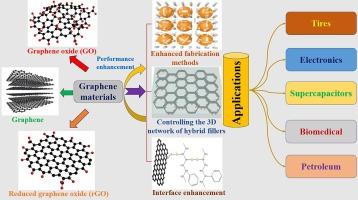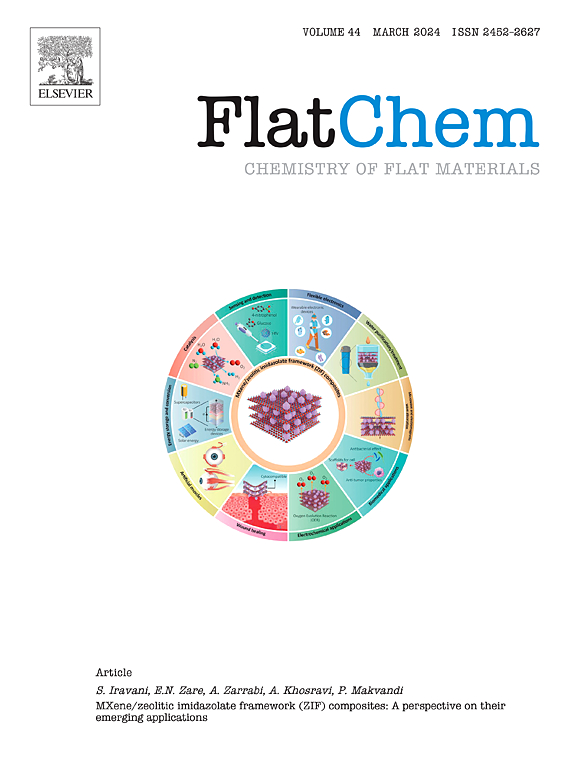The emergence of graphene and its nanomaterials based natural rubber nanocomposites: A short review on the latest trends on its preparations, properties and applications
IF 5.9
3区 材料科学
Q2 CHEMISTRY, PHYSICAL
引用次数: 0
Abstract
The two-dimensional (2D) graphene material has been a rising star in the area of polymer nanocomposites and materials science due to its excellent mechanical, electrical and thermal properties, gas barrier performance and high surface area. Hence, this makes graphene and its nanomaterials an ideal multifunctional filler for rubbers, which improved the overall properties of the natural rubber (NR) matrix. However, in order to tailor the interfacial interaction, appropriate graphene dispersion, the vulcanization kinetics etc., it is vital to carefully consider the utilization of the graphene properties in the rubber nanocomposites to yield high quality nanocomposites. This review offers the coverage on the recent methods and trends to uniformly disperse nanofillers in rubber matrix, to construct a strong interfacial interaction between the NR and graphene and the effects of graphene oxide (GO) and reduced GO (rGO) on the vulcanization behaviour of NR nanocomposites. The properties of these nanocomposites will be discussed to provide an intuition into the major necessities of graphene fillers with respect to several industrial applications. Finally, the challenges that need to be addressed in order to attain advanced device performance will be discussed along with the future perspectives. It is envisaged that the outstanding functional properties of the 2D fillers and their combinations could be exploited to fabricate graphene/NR nanocomposites, thus making it a potential candidate as a new class of advanced materials in the near future.

基于石墨烯及其纳米材料的天然橡胶纳米复合材料的出现:石墨烯及其纳米材料基天然橡胶纳米复合材料的出现:有关其制备、性能和应用的最新趋势简评
二维(2D)石墨烯材料因其优异的机械、电气和热性能、气体阻隔性能和高比表面积,已成为聚合物纳米复合材料和材料科学领域一颗冉冉升起的新星。因此,石墨烯及其纳米材料成为橡胶的理想多功能填料,可改善天然橡胶(NR)基体的整体性能。然而,为了定制界面相互作用、适当的石墨烯分散、硫化动力学等,必须仔细考虑如何在橡胶纳米复合材料中利用石墨烯的特性,以获得高质量的纳米复合材料。本综述介绍了在橡胶基体中均匀分散纳米填料、在 NR 与石墨烯之间构建强界面相互作用的最新方法和趋势,以及氧化石墨烯 (GO) 和还原 GO (rGO) 对 NR 纳米复合材料硫化行为的影响。我们将讨论这些纳米复合材料的特性,以便让人们直观地了解石墨烯填料在几种工业应用中的主要必要性。最后,还将讨论实现先进设备性能所面临的挑战以及未来展望。预计二维填料及其组合的出色功能特性可用于制造石墨烯/NR 纳米复合材料,从而使其在不久的将来成为一类新型先进材料的潜在候选材料。
本文章由计算机程序翻译,如有差异,请以英文原文为准。
求助全文
约1分钟内获得全文
求助全文
来源期刊

FlatChem
Multiple-
CiteScore
8.40
自引率
6.50%
发文量
104
审稿时长
26 days
期刊介绍:
FlatChem - Chemistry of Flat Materials, a new voice in the community, publishes original and significant, cutting-edge research related to the chemistry of graphene and related 2D & layered materials. The overall aim of the journal is to combine the chemistry and applications of these materials, where the submission of communications, full papers, and concepts should contain chemistry in a materials context, which can be both experimental and/or theoretical. In addition to original research articles, FlatChem also offers reviews, minireviews, highlights and perspectives on the future of this research area with the scientific leaders in fields related to Flat Materials. Topics of interest include, but are not limited to, the following: -Design, synthesis, applications and investigation of graphene, graphene related materials and other 2D & layered materials (for example Silicene, Germanene, Phosphorene, MXenes, Boron nitride, Transition metal dichalcogenides) -Characterization of these materials using all forms of spectroscopy and microscopy techniques -Chemical modification or functionalization and dispersion of these materials, as well as interactions with other materials -Exploring the surface chemistry of these materials for applications in: Sensors or detectors in electrochemical/Lab on a Chip devices, Composite materials, Membranes, Environment technology, Catalysis for energy storage and conversion (for example fuel cells, supercapacitors, batteries, hydrogen storage), Biomedical technology (drug delivery, biosensing, bioimaging)
 求助内容:
求助内容: 应助结果提醒方式:
应助结果提醒方式:


